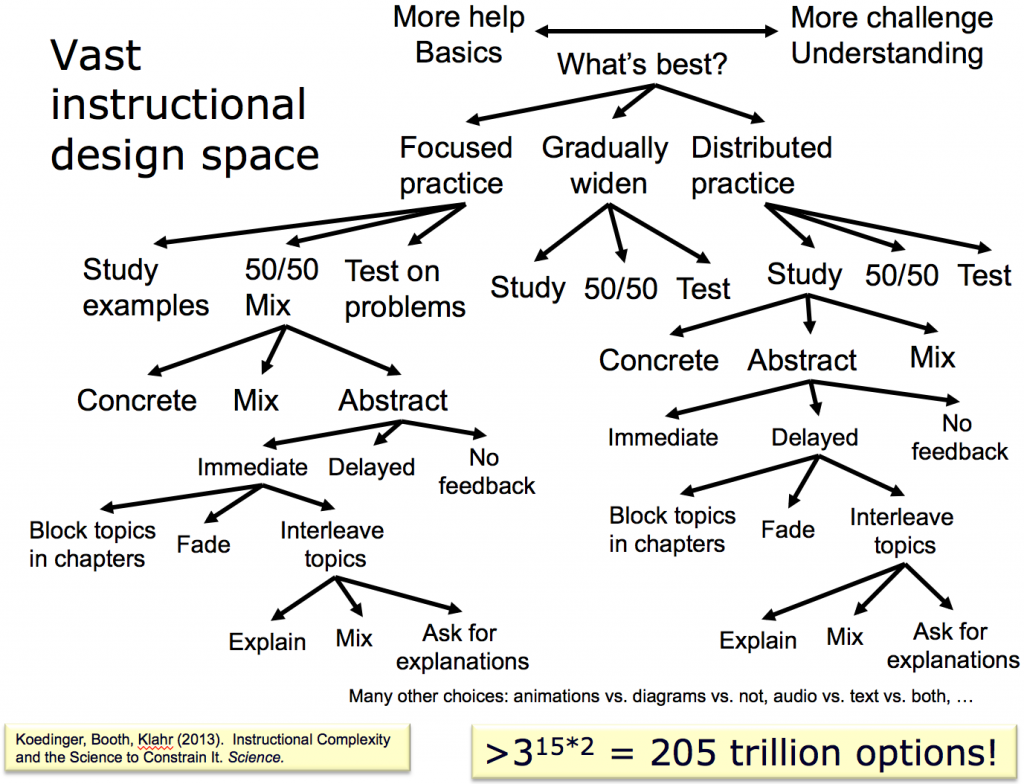Upcoming Events
- Masters of Educational Technology and Applied Learning Science (METALS) question and answer webinar on Wednesday, November 9th at 11:00 AM EDT.

- Masters of Educational Technology and Applied Learning Science (METALS) applications due December 15th
About LearnLab
LearnLab (https://learnlab.org) started in 2004 with 10+years of funding from NSF. Here we summarize our results as of January, 2016. LearnLab has pursued a focused mission in research and training toward advancing a practical science of robust student learning. It has become a sustainable research and training cooperative. The steadfast mission has been to leverage cognitive theory and computational modeling to identify the instructional conditions that cause robust student learning. Of many discoveries that the center produced, a distinct and unifying discovery is that within the vast space of instructional design (Koedinger, Booth, & Klahr, 2013), there is no one-size-fits-all answer to optimizing robust student learning. Instead, it is critical to perform a deep analysis of both the domain content and of the learning processes that lead to the acquisition of this content (Koedinger, Corbett, & Perfetti, 2012, cited by 147).
From the early history of the center, the development of a shared theoretical framework was a center-wide endeavor. Going beyond the usual progress of science through collaborative publications, we facilitated shared theory development through an open research wiki. More fundamentally, we systematically produced a vast and rich empirical basis for theory development by facilitating over 360 cross-domain classroom-based in vivo experiments and amassing over 850 datasets on the student learning processes in the open data repository DataShop. Collectively, this data involves nearly 200 million coded observations of student learning behaviors. This data was collected through student interactions with widely disseminated and highly effective educational technologies (VanLehn et al., 2005, cited by 492; Koedinger & Corbett, 2006, cited by 359; Lovett, Meyer, & Thille, 2008, cited by 107). This data has led to basic research insights into the causal mechanisms of implicit and explicit learning processes and the social and motivational conditions that enable them. By integrating insights across the center, we advanced an education-relevant learning theory that culminated in the Knowledge-Learning-Instruction (KLI) framework (Koedinger, Corbett, & Perfetti, 2012). The KLI framework demonstrates how different knowledge goals require different optimal configurations of instructional techniques because they require different primary learning processes (memory, induction, or sense making).
Many subsequent projects and publications have pursued the KLI Framework. One of those publications appeared in Science (Koedinger, Booth, & Klahr, 2013) and presented the challenge of “instructional complexity” – that there are over 200 trillion different ways to design for optimal learning and that a one-size-fits-all solution does not work (see Figure 1). The paper provides recommendations for addressing this complexity through employing the KLI Framework and the kind of socio-technical cyberinfrastructure that LearnLab has developed. A bottom line message is that all schools and colleges should become LearnLabs – institutions committed to and capable of continuous improvement in robust student learning outcomes through a data-driven iterative engineering process.

Figure 1. The options for designing effective learning are vast and research studies confirm that no one-size-fits-all approach works for all courses and students. Educational institutions must commit to research-practice collaborations to explore this vast space to identify what works best when.
Our focus on educational technology data was critical in the formation of a new field of Educational Data Mining (cf., Baker & Yacef, 2009, cited by 590). LearnLab research thrusts produced learning science results that will have lasting impact in areas of Cognitive Factors (e.g., Klahr, Zimmerman, & Jirout, 2011; Guan, Liu, Chan, Ye, & Perfetti, 2011), Metacognition and Motivation (e.g., Aleven, Mclaren, Roll & Koedinger, 2006, cited by 247), Computational Modeling and Data Mining (e.g., Baker, Corbett, & Aleven, 2008, cited by 183; Cen, Koedinger, & Junker, 2006, cited by 191), and Social Communication (Resnick, Asterhan & Clarke, 2015). We also contributed to influential reviews of learning science (Ambrose et al., 2010, cited by 581; Pashler et al., 2007, cited by 278 — see top left of Figure 6), of machine learning and data mining in cognitive science and education (Koedinger et al., 2010 cited by 208; Koedinger, Brunskill, Baker, McLaughlin, & Stamper, 2013; Koedinger, D’Mello, McLaughlin, Pardos, & Rosé, 2015), and of advanced educational technologies (Koedinger & Corbett, 2006, cited by 359; VanLehn, 2006, cited by 470; VanLehn, 2011, cited by 363).
In the course of the center’s operation, our researchers have produced 2075 publications, including 316 journal articles, 9 books, 124 book chapters and 232 invited talks. The list of our 100 most cited publications in Appendix A gives a sense of influence. We have trained 138 graduate students and 47 post-doctoral students. Over 150 undergraduates have participated in our summer internship program. Another 400 graduate students, faculty, and industry professional have attended our annual week-long intensive learning science workshop. While our 2000+ publications leave a vast legacy of research outcomes, we have and continue to have an equally transformative effect on practice through transfer of scientific discoveries, methods, and technologies.
A highlight of the center’s sustainability is the creation of the Simon Initiative , which includes the formation of a Global Learning Council, a long-term commitment to the LearnLab data repository, and the development of a professional Masters in Educational Technology and Applied Learning Sciences (METALS), now in its third year.


